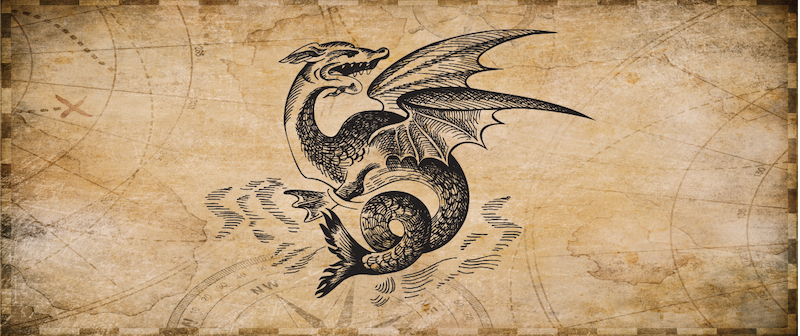Thoughts on Leadership: How to Ride the Dragon

Here, there be dragons.
This marking on ancient maps signaled terrible danger for any ship’s captain, from rough seas to jagged cliffs, warning to steer clear. It also left many lands uncharted and opportunities unexplored. In today’s fast-paced markets, leaders no longer have the luxury of avoiding the modern equivalent of these fire-breathing monsters. At a certain point, we have to face our personal “dragons” – those obstacles preventing us from achieving professional growth and becoming authentic leaders.
I work with many talented people at RGA EMEA and learned that leading yourself is the path to growth, and that leading others is an incredible privilege. In this article I share some of the lessons on ways to master personal dragons and turn them to your advantage.
How can you battle a dragon without getting burned? An old Chinese proverb has lessons for today: “If you ignore the dragon, it will eat you. If you try to confront the dragon, it will overpower you. If you ride the dragon, you will take advantage of its might and power.” In other words, if you can’t ignore it or beat it, use the most seemingly insurmountable obstacles to your advantage.
The dragon of unfulfilled expectations
Dragons come in many shapes and forms, but they all do the same thing: they block your path. Nowadays, however, one dragon creates more victims than most: the dragon of unfulfilled expectations. I see many young talented professionals wondering why their mental picture of an ideal world takes so long to become reality. After all, social media is rife with posts from people who portray images of their perfect lives, successful careers, wonderful travel and friends.
The good news is: the picture of the ideal world is a mirage – instant success and amazing perfection are not real. The bad news is: this expectation is a dragon who eats you from the inside. It is a creature that calls to you, telling you that if you push hard enough, fulfill (non-existing) expectations and comply with “the picture,” everything will be OK. But it never will… because this image of perfection is an illusion.
Rather than fighting this reality or ignoring it, ride the dragon. Here are my thoughts on how you can climb aboard by addressing the toughest challenges first, focusing more on what really matters, and telling stories.
Above all, recognize that our authentic personal and professional lives are much messier, more imperfect, and ultimately more rewarding than any false narrative. Embracing this makes all of us better leaders and better people.
“Rocking” the dragon of distraction
“Better put in your big rocks first.” - Steven Covey
Steven Covey, author of The Seven Habits of Highly Effective People, often compares leadership to a jar filled with fist-sized rocks. Is this jar full? He calls on audiences to imagine pouring in gravel, and then sand, and finally liquid – and each time he asks if more could fit in the jar.
He concludes by asking the audience what the analogy was intended to illustrate. Someone invariably suggests that, “No matter how busy your schedule, you can always stuff more in.”
“No,” Covey replies. “If you don’t put the big rocks in first, you’ll never get them in at all.”
In other words, we must stay focused on more complex challenges and long-term goals – the big rocks – before addressing the smaller, easier tasks that so easily consume all our attention. Covey gained fame by giving good advice. My advice is that anyone wishing to be a better leader ask themselves two questions:
- Do you know what your big rocks are, both in work and private life? So often, achieving the smaller stuff can feel like moving boulders. Reaching less significant goals provides a short-term feeling of satisfaction and positive buzz – but masks an unpleasant reality: while we feel productive, we could be losing track of much more meaningful, long-term objectives.
- How do your big rocks align with your organization’s broader objectives? How can you lead yourself and others if you are not sure what your big rocks are, and/or are not focused on addressing the right goals? Think about it; it’s a sobering and helpful exercise.
All this sounds easy, so why has almost no one put this advice into practice? We live in a distracted age. Mobile computing has turned us into a nation of multitaskers, constantly pausing to check smartphones, web browsers, messaging apps, shopping sites, and endless social networks. This phenomenon even has a name – FOMO, or Fear of Missing Out. We fall into the trap of believing every beep could signal a particularly important big rock, when in fact these are small, distracting pebbles. The moment we learn that a text message or email is frivolous and put aside our devices, we hear another notification and start all over again. We are in a distraction loop. Distraction is surely one of your dragons.
The problem is that true multitasking is a myth. Our brains cannot focus fully on two things simultaneously – inevitably, rapid attention-switching exacts a cognitive cost. Mega-boost your productivity and emphasize your “big rocks” with a 45-minute rule. Focus on one “big rock” task for 45 minutes, then pause to catch up on other media – the smaller rocks and grains of sand – before returning to another larger task.
True leadership requires all of us to set aside distractions, reclaim our time, and return our focus to the real challenges in life. So, how do you identify and emphasize what really matters?
The dragon of misplaced perfection: start, stop, go!

When I was a boy, I was handed my first Swiss Army knife. I can still recall feeling amazed at its versatility. There was a tiny screwdriver, a clipper, a knife, and even a bottle opener. It took some time for me to realize that I wasn’t using my knife much, because only a few of the tiny devices packed into the red case were very effective.
From an early age, we have been taught that to excel in our life we need to improve the skills that do not come naturally to us. We spend enormous time and effort on overcoming deficits, rather than focusing on areas where we already surpass our peers. Every leadership or management course seems to leave us with a list of “improvements” to make, rather than strengths to refine.
The dragon of misplaced perfection roars that we must address every gap. This approach essentially rewards a negative; if we focus on what we’re not good at we may achieve better, but still mediocre, results. All that time and energy instead could have been directed at achieving true mastery in fewer areas. We all become Swiss Army managers: useful, even admirable, but left in the box on projects requiring real leadership.
If you are chronically over-committed and under-performing, why not focus on your core skills, the things you really like and are really good at? It is easier – and more fun - to improve this skill set. I like to think of this as “start-doing, stop-doing” leadership. Ask yourself which of your responsibilities would you prefer to stop doing, and what would you prefer to start doing, if only you had the time? We all have to perform mundane or unpleasant tasks from time to time, but if these are consuming your career, it’s time to rethink and reorganize your areas of focus. As a result of emphasizing what you want to do, you will become a more authentic leader, a person that other people want to work for, learn from, and follow.
The dragon of unproductivity; tell a tale!
“Get motivated. Be creative. Love your job.”
How often has anyone heard these orders from truly effective leaders? Never, I imagine. Yet organizations frequently set forth strategic objectives and expect everyone to get excited about achieving them. You can’t order employees to feel a certain way – that’s not how the human brain works.
You can, however, lead people to share your enthusiasm with the power of a good tale.
Recognize this simple fact: your leadership is only as good as your story. In today’s knowledge economy, every company behaves like a system of conversations. If the system works, everything works. If the system is interrupted, or that chain of connections is broken, conversations stop and, in the end, results suffer. Teams go their own ways, disengaged, and inefficiencies and productivity losses follow.
How do you encourage engaged teams, high-performance cultures, authentic leadership and fulfillment? In one word, storytelling. Take your team on a journey. Tell them about overcoming the odds, defeating dragons. Give your vision context by describing what success looks like; teach lessons about culture and values by sharing times when you made the wrong choices and accepted the consequences; or share your personal background to explain who you are and what you believe.
Storytelling also is two-way. A great tale almost always inspires even better feedback and provides a sharper insight on goals and the journey itself. The biggest barrier is not having any stories to tell. Great storytelling also requires leaders to sit down, slow down and talk to their teams. Ask questions, and listen to the answers.
Of course, a tale isn’t always appropriate for every task. Setting key performance indicators, for example, requires a spreadsheet and not a story. But once you decide on a strategy, a great story can convince your team to line up behind your objectives. In other words, storytelling may not help you manage, but it will help you lead.
Is it that easy? Yes. Storytelling as an integral part of my job. It fosters more creative thinking and “sticky” results compared to the familiar heads-down culture in many corporations. Frequently, the art of storytelling – of creating simple, human connection – is overlooked. Why? Because of the perception there is too little time and too many dragons, and we have to get to the next meeting or the next client.
Then we wonder why employee engagement scores decline and why our mission or our goals are not clearly understood and executed. The formidable fire-breathing dragon is the false belief that productivity is more important than personal relationships, and that we can achieve great things without truly believing in – and being inspired by – a shared objective. No slick employee promotional campaign or flashy teambuilding Instagram pictures can replace relationships built on trust, authenticity and, perhaps most of all, a great story.
We want to ride the dragons we face in our leadership journey, rather than defeat them, because they can be useful. Having expectations is important in goal-setting; we want to be alert and not “miss out”; we do want to improve ourselves; we do value productivity. These dragons must be directed, however, so they serve us, not eat us. Knowing what we want, and how we’re going to achieve it, helps us keep these in the proper perspective so that they don’t get too big.
This article is a compilation of my Thought of Leadership blogs which I published on LinkedIn. To learn more about RGA’s leadership in reinsurance, visit www.rgare.com or contact us to learn how RGA EMEA can help achieve your objectives.

